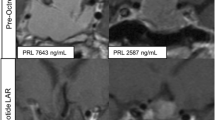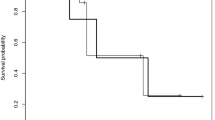Summary
Background. Prolactinomas usually exhibit a benign course and can be safely and effectively managed by dopamine agonists (DA). However, some are locally invasive and may show resistance to DA therapy, and the management of such cases remains controversial. The aim of the present study was to determine whether histological features and markers of cell proliferation correlated to the clinical behaviour of prolactinomas and with DA resistance.
Method. This retrospective study included 74 cases (36 men and 38 women) who had monohormonal prolactinomas removed by transsphenoidal surgery. The prolactinomas were categorized on the basis of tumour size (48 macroadenomas), invasion of the cavernous sinus (n = 31), and resistance to bromocriptine (BRC) therapy (n = 14). Group 1 consisted of non-invasive microprolactinomas (n = 24), group 2 of non-invasive macroprolactinomas (n = 19), group 3 of invasive non-BRC-resistant tumours (n = 19), and group 4 of invasive BRC-resistant tumours (n = 12). The later group included one case of carcinoma with bone and lung metastases. Seven additional parameters were studied, these being age, sex, basal prolactin (PRL) levels, the Ki-67 and PCNA labelling indices (LI), mitotic count, and cellular atypia.
Findings. Age and preoperative PRL levels did not correlate to the histological parameters studied. Tumour size and invasion were related to cellular atypia and the Ki-67 LI. BRC-resistant tumours were more frequently invasive (12/14) than BRC-responsive tumours (11/30; p = 0.002) and were more frequent in men than in women (33 versus 5%; p = 0.003). BRC-resistant tumours had a higher Ki-67 LI and mitotic count (4.2±2.0% and 4±1, respectively) than other tumours (0.7±0.2% and 1±0, respectively; p<0.05). The strongest correlations with tumoural staging were seen with male sex and high mitotic activity. Six out of the 12 invasive BRC-resistant macroprolactinomas, including the PRL secreting carcinoma, exhibited histological features of aggressiveness (a mitotic count ≥3 [i.e. in the fourth quartile] and/or a high Ki-67 LI and cellular atypia).
Conclusions. In this surgical retrospective series, histological signs of aggressiveness are present in 50% of invasive and BRC-resistant prolactinomas, which are more frequent in men than in women. This fits with the behaviour of BRC-resistant prolactinomas, which can continue to grow despite DA treatment. These findings justify the long-term follow up of these tumours, and the use of surgery and/or radiotherapy if there is concern about the control of tumour growth.
Similar content being viewed by others
Author information
Authors and Affiliations
Rights and permissions
About this article
Cite this article
Delgrange, E., Sassolas, G., Perrin, G. et al. Clinical and histological correlations in prolactinomas, with special reference to bromocriptine resistance. Acta Neurochir (Wien) 147, 751–758 (2005). https://doi.org/10.1007/s00701-005-0498-2
Received:
Accepted:
Published:
Issue Date:
DOI: https://doi.org/10.1007/s00701-005-0498-2




